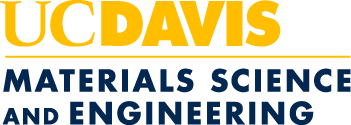
Ph.D. Student Dayne Sasaki Receives DOE Fellowship to Study Artificial Spin Ice Materials
With support from the Department of Energy Office of Science’s Graduate Student Research program, Materials Science and Engineering Ph.D. student Dayne Sasaki will be using the Advanced Light Source (ALS) at Lawrence Berkeley National Lab to conduct groundbreaking research that combines the fields of artificial spin ices and complex oxides.
Artificial spin ices are synthetic magnetic materials modeled after spin ice crystals, whose arrangement of spins resemble the structure of water as ice. By replicating this arrangement of spins with 2D arrays of nanomagnets, researchers can use artificial spin ices to directly see the behavior of these systems using magnetic microscopy techniques.
Computers can only get so small, fast and efficient with current approaches, so researchers are interested in alternative methods like spintronics, which use magnetic up and down spins instead of electronic 1’s and 0’s to do computation. Artificial spin ices have the potential to be building blocks of this next-generation technology.
Most artificial spin ices are made with metal alloys that have a specific and limited range of properties. To change this, Sasaki and Professor Yayoi Takamura’s lab are instead looking to build them with complex oxides—multi-element materials that are tunable and have a wide range of electronic and magnetic properties.
“By straining these complex oxides, changing their composition slightly, or growing them into multilayered structures, there’s a rich array of physics that we can introduce into a system that has already been extensively-studied,” said Sasaki.

Introducing New Physics
To understand how to manipulate the materials to introduce new magnetic properties, the team needs to understand its multi-layered complex oxides as individual crystals and as whole fabricated nanostructures. The ALS is the perfect place to do this, as its unique element-specific x-ray capabilities allow Sasaki to study the magnetic properties of each of the layers in the complex oxide.
“It’s looking both at what’s going on between and within each individual magnet [in the artificial spin ices], but also looking at things as a collective,” he said. “The nanomagnets are all kind of intertwined with each other, so if we’re independently changing one thing, it can cause several different things to happen. We therefore have to take both pictures into consideration to provide a comprehensive picture of what’s going on.”
The project will build on the team’s recent study featured in Physical Review Applied. They showed that by changing the spacing of the nanomagnets in the complex oxide spin ice structure, they can toggle the material’s magnetic field from a traditional straight up and down bar magnet to a circular vortex.
“Most people assume that the magnetic domains are pre-determined by the [nanomagnet] shape in tandem with the material properties,” he said. “We never expected by just changing the spacing that that can sort of toggle this switching between a single domain bar magnet to something like a vortex.”
The team constructed phase diagrams for the phenomenon and Sasaki says they’re currently studying which combinations of widths and spacings in the material will prefer a single-domain bar magnet or a vortex-like state. Understanding this physics and how to manipulate it will give researchers new tools to build next-generation devices.
Sasaki feels grateful to be doing work that interests, engages and challenges him on a daily basis and he looks forward to using the ALS’ “cool toys” to contribute new insights to the emerging field during his fellowship.
